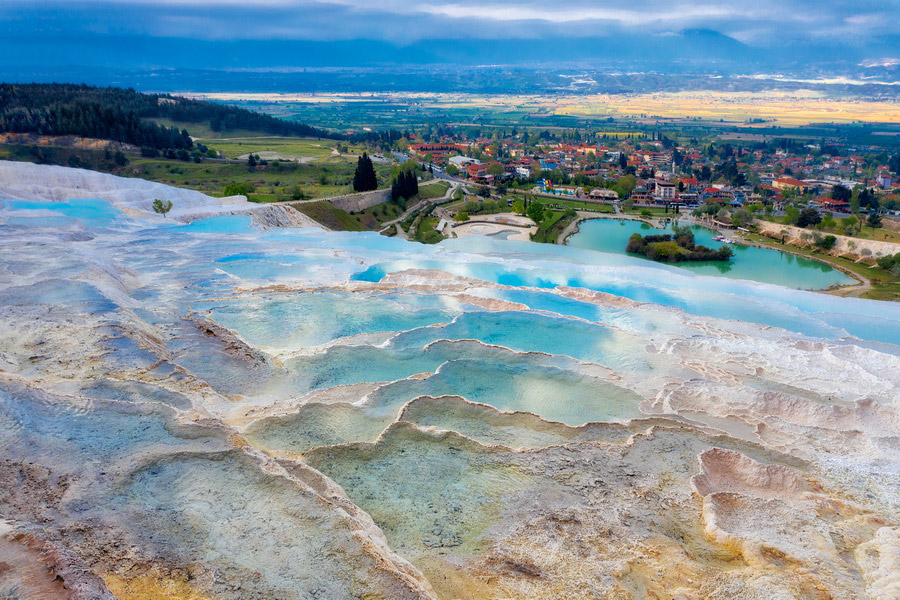Tours, Attractions, and Things to Do in Pamukkale
In Pamukkale, earth dreams in marble, crystalline terraces shimmer under the sun, and the ethereal terrain, with its bright white formations, feels like a natural cathedral sculptured by time. In antiquity, Pamukkale was the core focus of interest for visitors to the nearby Hellenistic spa town of Hierapolis. Founded by Greek settlers, the ancient town extended, and its population reached 12,000. It was a destination for rejuvenation and a thriving cultural and religious hub.
Meaning "Cotton Castle" in Turkish, Pamukkale is one of the world's oldest and most renowned thermal baths, nestled in the southwest of the country. Serving from the 2nd century B.C., Pamukkale is charged with therapeutic waters, thermal installations, spring-fed hot basins and pools for swimming, and additionally a storied past.
This UNESCO World Heritage site is renowned for its cascading terraces of white travertine pools and an extraordinary geological structure shaped by the mineral-rich waters of the region, along with the cultural riches of Hierapolis. The pools, gleaming in hues of crystal blue, have drawn visitors for millennia. As time flows in silence here, each step across Pamukkale’s petrified cascades feels like a dreamscape of tranquillity.
Pamukkale Tours
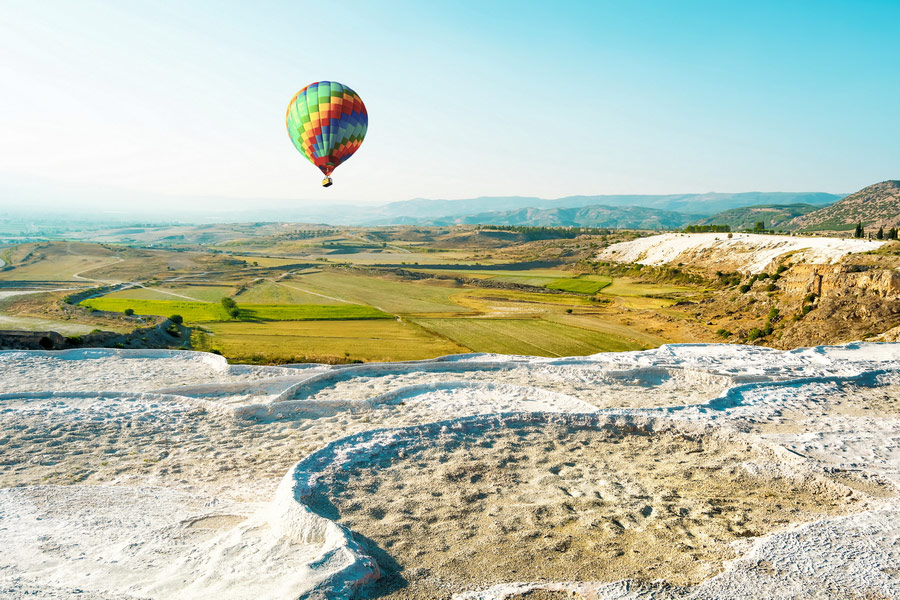
A journey to Pamukkale typically starts in Denizli, where travellers head to the stunning white terraces, glowing like snow in the sun; however, some visitors prefer to visit these mineral-rich thermal waters from other destinations guided by special bus tours from Marmaris, Izmir, Istanbul, Antalya, or even Cappadocia.
Here, you can enjoy a walk along the terraces, barefoot through the warm, smooth waters, especially at sunset when the landscape glows golden. While a day trip offers a taste of Pamukkale’s beauty, staying overnight allows for peaceful exploration of nearby springs and quieter trails once the crowds have gone.
Best Time to Visit Pamukkale
During the summer months (April to October), the site is open from 6 a.m. to midnight, giving you ample time to explore the terraces and wander through the ancient ruins. However, for those looking for a quieter visit, the best months are April to June, when the weather is warm but not scorching and the crowds are less overwhelming. Pamukkale’s small town is also home to a varied number of hotels, from simple to luxury.
History of Pamukkale
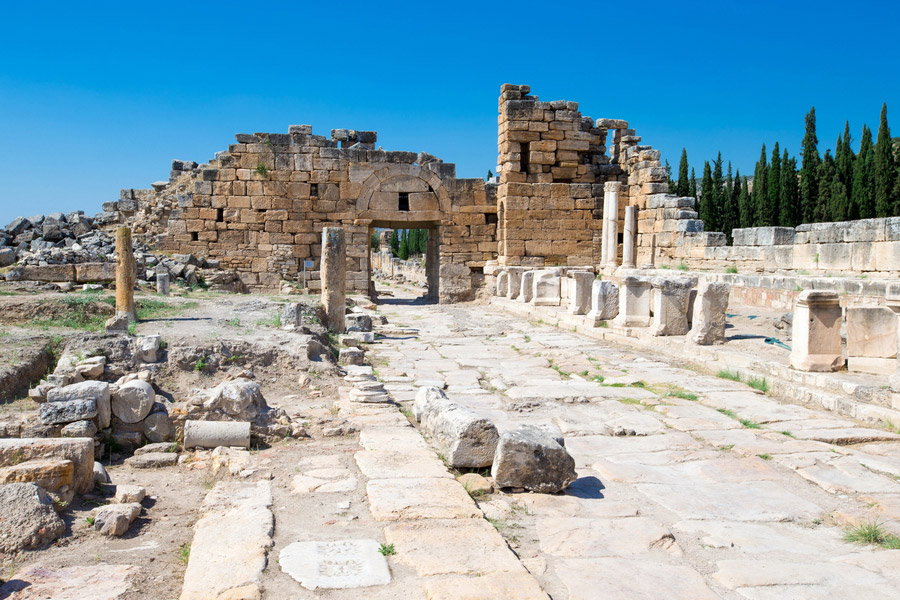
Dating back to the 2nd century B.C., Pamukkale represents the centrepiece of the historic city of Hierapolis, which in ancient times was believed to be a gateway to the underworld because of its toxic gases from deep within the earth. The 1st-century Greek geographer and historian Strabo (Strabon) described it as the Ploutonion “Gate to hell” as "misty and dense that one can scarcely see the ground". Founded by the Attalid dynasty, the kings of Pergamon, Hierapolis in Pamukkale still feels like a scene from a fable. The flourishing of Pamukkale/Hierapolis was at its peak in the 2nd century A.D., while adjusting its identity after Emperor Constantine the Great (I. Konstantin)'s acceptance of Christianity and the founding of Constantinople. The city additionally evolved into an eastern Roman religious hub because of St. Philip's martyrdom.
In the early 7th century, Persian invasions and a severe earthquake left the town in ruins, with a slow recovery following. By the 12th century, the Seljuks of Konya controlled the region until it briefly fell to Crusaders and Byzantines in 1190. After being deserted for about three decades, the Seljuks constructed a castle in the 13th century, though it too was abandoned by the late 14th century. The great Thracian earthquake of 1354 then destroyed the ancient remnants, eventually burying them beneath thick limestone deposits. The site was then rediscovered by European archaeologists in the late 20th century, and its current appearance is the aftermath of the anastylosis method, which means the restoration of ruined monuments by reassembling fallen parts.
With noblemen arriving here on their deathbeds, doctors taking their patients to its healing waters for treatment, and the statue of Hades with his three-headed dog, this eerie destination is a subtle combination of serene beauty and ancient mystery.
Things to Do in Pamukkale
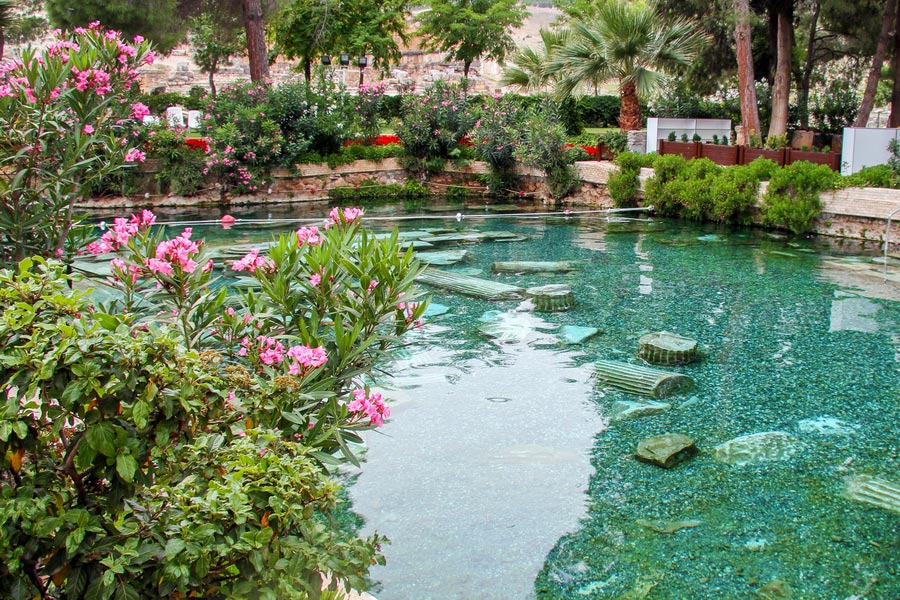
Pamukkale enchants with its white travertines and warm, healing pools. Cleopatra’s Pool (Kleopatra Havuzu) invites you to swim among ancient Roman columns, while hot air ballooning delivers breathtaking views of this natural wonder.
Landmarks and Attractions in Pamukkale
Entertainment
The major attraction of Pamukkale is the thermal pools created by the water deriving from springs in a cliff almost 200 metres high overlooking the plain. Made up of mineral forests, petrified waterfalls, and a series of terraced basins, these calcite-laden waters shaped the Cotton Castle's unreal landscape. Pamukkale's thermal pools are an essential asset of the site, where the visitors have a fortune's favour to immerse themselves in the aged healing waters that have flowed for thousands of years.
The nearby Cleopatra's Pool, with submerged Roman columns, grants an experience where you can literally bathe in history. According to the legend, Cleopatra herself swam here, and today, for an additional ticket, you too can float among these ancient relics.
Last but not least, an exhilarating experience providing breathtaking aerial views of Pamukkale and its crystal-blue travertines is Hot Air Balloon and Paragliding Tours, granting visitors the opportunity to appreciate the beauty from a unique perspective.
Pamukkale Museums
The soul of ancient craftsmanship at the Denizli Hierapolis (Pamukkale) Archaeological Museum (Hierapolis (Pamukkale) Arkeoloji Müzesi), an awe-inspiring 14,000 square metres complex, exposes the grandeur of a Roman bath, gymnasium, and library from the 2nd century A.D. With roots tracing back to Emperors Hadrian and Severius, the site embodies the layers of history, enriched by Pamukkale's iconic travertines. Since 1984, the museum has showcased remarkable relics, from the dramatic relief of Marsyas' mythical duel with Apollo to exquisite Roman sarcophagus, gladiator friezes, and treasures from Hierapolis, Laodicea of the Lycus (Laodikeia), and beyond. Marvel at millennia-old artefacts, terracotta lamps, Byzantine jewellery, and Phrygian relics, capturing the artistic brilliance of civilisations of the past.
Pamukkale Theatres
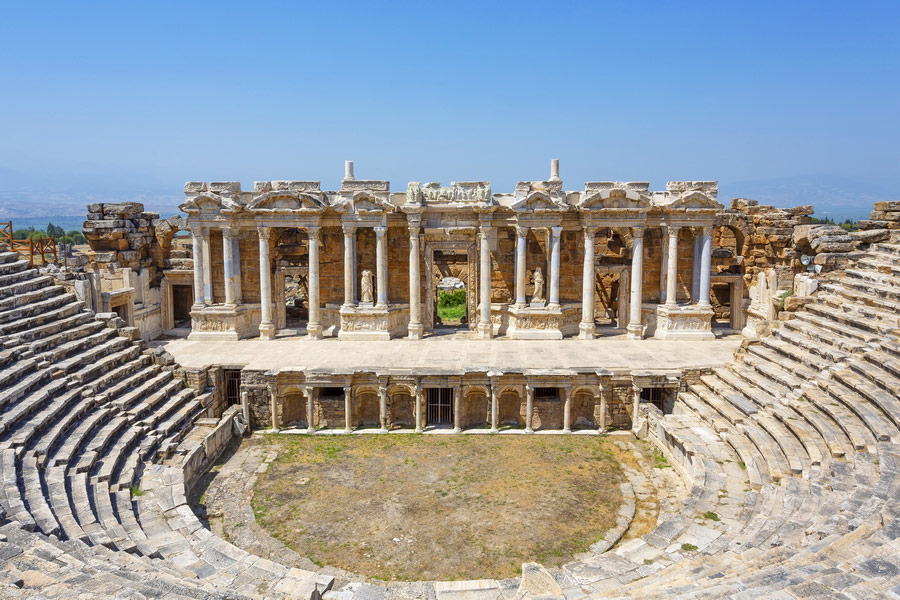
Towering over the travertines of Pamukkale, the Hierapolis Theatre (Hierapolis antik tiyatro) reigns as one of the finest remnants of Roman engineering. Its sweeping marble tiers once held over 10,000 spectators. Constructed during Emperor Hadrian’s reign and later monumentalized under Septimius Severus, the theatre is a testament to resilience and craftsmanship, enduring earthquakes and centuries of transformation.
The scaenae frons, an architectural triumph, was graced with mythological friezes and Corinthian columns. Tales of Dionysus, Artemis, and Roman emperors are etched into its stone, inviting visitors to imagine the drama that once unfolded here. Today, extensive restoration has pieced together much of its former splendour, blending original marble with modern stabilisers.
A visit to the Hierapolis Theatre is a journey into the heart of antiquity. Pair it with Pamukkale’s famous white travertines or a hot-air balloon ride for an unforgettable panorama of this UNESCO World Heritage Site.
Shopping in Pamukkale
Pamukkale’s charm extends beyond its baths and terraces to its delightful shopping scene. Nestled in a quaint hillside town, its shops reflect the region’s rich heritage. Denizli’s famed cotton textiles dominate the contribution, with towels, bathrobes, and handmade household goods crafted from the finest Buldan fabric.
For a touch of artistry, there are stalls adorned with onyx and marble carvings — symbols of the area's geological treasures. From sleek vases to desert hare figurines, these souvenirs seamlessly merge utility with beauty. Denizli’s iconic long-crowing rooster inspires intricate glass figurines, a unique keepsake to commemorate your visit.
Wine enthusiasts can indulge in locally produced vintages from the renowned Pamukkale Winery, crafted from the Çalkarası grape, a variety deeply rooted in Anatolian tradition. For those with a sweet tooth, Turkish Delight in endless flavours awaits discovery.
Food in Pamukkale
In Pamukkale, food has a memory and identity as it’s deeply rooted in Aegean traditions and agroecosystems. From juicy kebabs to crispy baklava, this magical village of white terraces will nourish your day with savoury delights.
Turkish Cuisine
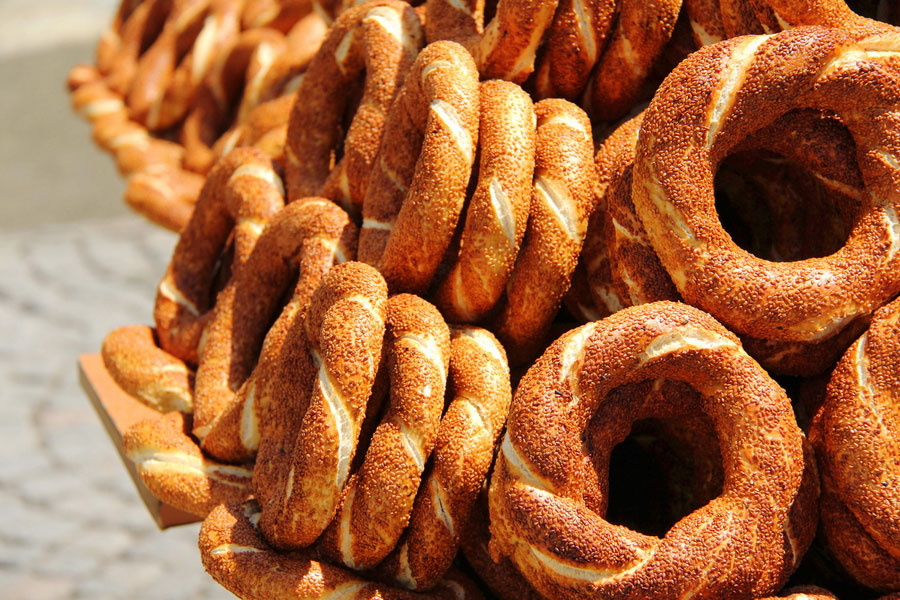
While most of the culinary delights and Turkish cuisine in Pamukkale are influenced by Aegean culture, general Turkish delicacies are surely widespread. The rich flavours of Denizli kebab, a tender, stone-oven masterpiece served with tomatoes and onions, epitomise tradition since the 1920s. For the adventurous, Kokoreç, grilled lamb intestines, delivers boldness in every bite.
The aroma of Turkish dishes, such as freshly baked pide, a Turkish pizza with toppings like cheese and spiced meat, is unforgettable, and the delicate artistry of manti, dumplings draped in garlicky yoghurt and paprika butter, is another journey to uncover. For lighter options Meze platters bring you hummus, baba ghanoush (Babagannuş), and more.
From the sesame-kissed simit to hand-stuffed mussels, Midye Dolma, Pamukkale’s streets hum with tang, accompanying your day trip as the perfect snack to the iconic hot springs. Additionally, don’t forget to sip on Denizli Gazoz, a fizzy local favourite drink, and snack on roasted chickpeas or baklava for a sweet touch.
For a full culinary immersion, visit local gems in Denizli like Garson Şükrü for kebabs or Gazezoğlu Pide for heavenly flatbreads.
Vegetarian Restaurants
Pamukkale delights vegetarians with unique culinary spots. For variety, Hiera Restaurant Coffee & Tea House delivers vegan, gluten-free, and vegetarian options with top-notch service. Kayaç’s Wine House serves exceptional grilled vegetables in a charming patio atmosphere. At Onur Restaurant, the kind owners customise aubergines and other vegetarian dishes, making it a must-visit for hearty meals.
Coffee Houses, Bakeries, and Patisseries
Pamukkale’s charm extends to its cosy coffee houses and delightful bakeries. From traditional simit and tea at a local café, to freshly baked pastries at Gülsüm Bacının Yeri, where the gözleme pairs perfectly with Turkish tea. Whether it’s aromatic coffee or flaky pastries, Pamukkale has a slice of heaven for every craving.
City Transport
Transport to Pamukkale flows through Denizli, a city with a bus terminal, railway station, and airport. Buses from Denizli’s Otogar connect to major cities like İzmir, Antalya, and Ankara, though reaching Cappadocia requires a transfer in Konya.
Trains, including the Pamukkale Ekspresi to Eskişehir, are cost-effective, comfortable alternatives to buses. The Denizli station links directly to İzmir, Selçuk, and Ephesus, making a day trip to Pamukkale seamless.
Buses and Shuttles
Though here time flows in silence, it's easily accessible, located just 20 kilometres from the town of Denizli, with shuttle services to take you directly to the travertines. Minibuses depart every 15–20 minutes for Pamukkale and nearby sights from Denizli.
Taxis
Taxis in Denizli, including street hails, stands, and apps like iTaksi, make reaching Pamukkale easy. Pamukkale Pilot Taksi has reliable standard service, airport transfers, package delivery, and scheduled rides, ensuring seamless travel and convenience.
How to Get to Pamukkale?
Visitors can also reach the site by bus from major cities like Istanbul, Izmir, or Antalya, with frequent services and picturesque views along the way.
Arriving early is key to getting rid of the crowds, with the best views and moments of peaceful solitude found by entering through the lower gate near the town and exploring the pools before the tour buses arrive.
Languages Spoken in Pamukkale
Even though in this tiny dreamland the official language is Turkish, because of 1.5 million visitors annually, the locals have widely adopted English, so adventurers can get by seamlessly. Throughout history, this village of surreal landscapes has been home to various civilisations, thus languages such as Greek, Lycian, Carian, and Lydian during the Attalid Dynasty and the kings of Pergamon, and kept the Byzantine Greek tongue until the fall of Constantinople. With the emergence of the Rome Rule here, Latin became predominant, while from the Seljuks you could hear Oghuz Turkic, Arabic, and even Persian languages.
Currency in Pamukkale
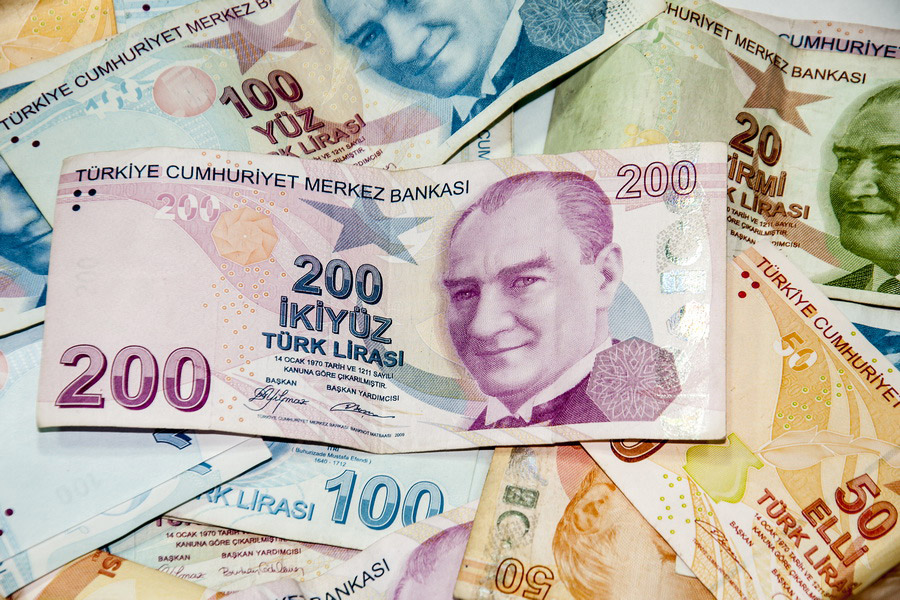
Pamukkale uses Turkish Lira (TRY), and ATMs, surprisingly, have better rates than exchange offices and are plentiful. Notify your bank before travelling, as ATM compatibility varies. Always select “without conversion” at ATMs to avoid poor exchange rates from foreign banks.
Security in Pamukkale
Visiting Pamukkale is an appealing encounter, and with standard safety guidelines in mind, you can fully enjoy this stunning destination. As one of the major tourist destinations in Turkey (Türkiye), with over 2 million visitors annually, Pamukkale is one of the safest destinations in the region. While exploring the iconic travertines, it’s best to wear comfortable clothing. Staying hydrated and protecting yourself from the sun, as temperatures can rise significantly, especially during the summer months, is a must.


